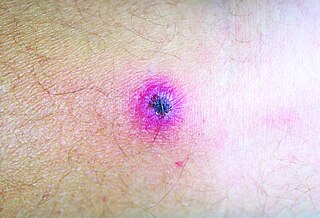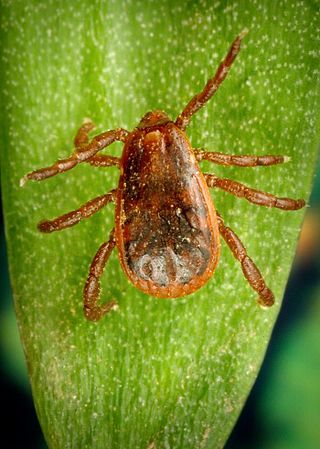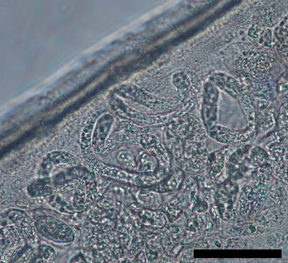Related Research Articles

Bartonella is a genus of Gram-negative bacteria. It is the only genus in the family Bartonellaceae. Facultative intracellular parasites, Bartonella species can infect healthy people, but are considered especially important as opportunistic pathogens. Bartonella species are transmitted by vectors such as ticks, fleas, sand flies, and mosquitoes. At least eight Bartonella species or subspecies are known to infect humans.

Rickettsialpox is a mite-borne infectious illness caused by bacteria of the genus Rickettsia. Physician Robert Huebner and self-trained entomologist Charles Pomerantz played major roles in identifying the cause of the disease after an outbreak in 1946 in a New York City apartment complex, documented in "The Alerting of Mr. Pomerantz," an article by medical writer Berton Roueché.

Lobomycosis is a fungal infection of the skin. It usually presents with bumps in the skin, firm swellings, deep skin lesions, or malignant tumors.
A rickettsiosis is a disease caused by intracellular bacteria.
Powassan encephalitis, caused by the Powassan virus (POWV), a flavivirus also known as the deer tick virus, is a form of arbovirus infection that results from tick bites. It can occur as a co-infection with Lyme disease, as both are transmitted to humans by the same species of tick. Over the last decade, there has been a surge in the number of cases and an expansion of its geographic range. In the United States, cases have been documented primarily in the northeast. The disease was first isolated from the brain of a boy who died of encephalitis in Powassan, Ontario, in 1958. This disease is classified as a zoonosis, originating in animals, often found in rodents and ticks, with subsequent transmission to humans. The virus shares antigenic similarities with the Far Eastern tick-borne encephalitis viruses.
Rickettsia akari is a species of Rickettsia which causes rickettsialpox.

Rhipicephalus sanguineus, commonly called the brown dog tick, kennel tick, or pantropical dog tick, is a species of tick found worldwide, but more commonly in warmer climates. This species is unusual among ticks in that its entire lifecycle can be completed indoors. The brown dog tick is easily recognized by its reddish-brown color, elongated body shape, and hexagonal basis capituli. Adults are 2.28 to 3.18 mm in length and 1.11 to 1.68 mm in width. They do not have ornamentation on their backs.

Rickettsia conorii is a Gram-negative, obligate intracellular bacterium of the genus Rickettsia that causes human disease called boutonneuse fever, Mediterranean spotted fever, Israeli tick typhus, Astrakhan spotted fever, Kenya tick typhus, Indian tick typhus, or other names that designate the locality of occurrence while having distinct clinical features. It is a member of the spotted fever group and the most geographically dispersed species in the group, recognized in most of the regions bordering on the Mediterranean Sea and Black Sea, Israel, Kenya, and other parts of North, Central, and South Africa, and India. The prevailing vector is the brown dog tick, Rhipicephalus sanguineus. The bacterium was isolated by Emile Brumpt in 1932 and named after A. Conor, who in collaboration with A. Bruch, provided the first description of boutonneuse fever in Tunisia in 1910.
Rickettsia typhi is a small, aerobic, obligate intracellular, rod shaped gram negative bacterium. It belongs to the typhus group of the Rickettsia genus, along with R. prowazekii. R. typhi has an uncertain history, as it may have long gone shadowed by epidemic typhus. This bacterium is recognized as a biocontainment level 2/3 organism. R. typhi is a flea-borne disease that is best known to be the causative agent for the disease murine typhus, which is an endemic typhus in humans that is distributed worldwide. As with all rickettsial organisms, R. typhi is a zoonotic agent that causes the disease murine typhus, displaying non-specific mild symptoms of fevers, headaches, pains and rashes. There are two cycles of R. typhi transmission from animal reservoirs containing R. typhi to humans: a classic rat-flea-rat cycle that is most well studied and common, and a secondary periodomestic cycle that could involve cats, dogs, opossums, sheep, and their fleas.

The northern white-breasted hedgehog is a species of hedgehog.

Dirofilaria repens is a filarial nematode that affects dogs and other carnivores such as cats, wolves, coyotes, foxes, and sea lions, as well as muskrats. It is transmitted by mosquitoes. Although humans may become infected as aberrant hosts, the worms fail to reach adulthood while infecting a human body.
Charles Pomerantz was a pest control expert and self-trained entomologist who played a pivotal role in identifying the etiology of a 1946 outbreak in New York City of what was later named rickettsialpox. In subsequent years, he spoke before audiences at colleges and other public forums about the menace from pests.
Rickettsia australis is a bacterium that causes a medical condition called Queensland tick typhus. The probable vectors are the tick species, Ixodes holocyclus and Ixodes tasmani. Small marsupials are suspected reservoirs of this bacterium.
Rickettsia felis is a species of bacterium, the pathogen that causes cat-flea typhus in humans, also known as flea-borne spotted fever. Rickettsia felis also is regarded as the causative organism of many cases of illnesses generally classed as fevers of unknown origin in humans in Africa.
Caño Delgadito orthohantavirus (CADV) is a hantavirus present in Venezuela. Its natural reservoir is Alston's cotton rat. Transmission among cotton rats appears to be horizontal. While human disease caused by CADV has not yet been identified, it has been isolated from oropharyngeal swabs and urine of infected cotton rats, indicating that it may be infectious to humans in the same manner as other hantaviruses, via inhalation of aerosolized droplets of saliva, respiratory secretions, or urine. CADV was discovered in the 1990s from rodent species in the Llanos in Venezuela.
Wesselsbron(WSL)virus is an arthropod-borne virus in the genus Flavivirus of the family Flaviviridae that causes Wesselsbron disease in cattle, sheep, goats, camels, pigs, donkeys, horses, ostriches, and wild ruminants with occasional incidental spillover to humans. It is transmitted by mosquitoes in the genus Aedes including A. caballus and A. circumluteolus.
Morogoro virus is an East African arenavirus infecting the multimammate mouse. The virus is genetically closely related to Lassa virus, known to cause Lassa fever in humans. Morogoro virus, however, does not seem to infect humans. Transmission of Morogoro virus between mice is assumed to occur via direct and indirect contact. Infected animals pass a latent period of 7 days and subsequently shed the virus for about 30 days, after which they recover and develop lifelong antibodies. Transmission may also be possible from infected mothers to offspring and through sexual contact, as this has been suggested for other arenaviruses.
Rodent mite dermatitis is an often unrecognized ectoparasitosis occurring after human contact with haematophagous mesostigmatid mites that infest rodents, such as house mice, rats and hamsters. The condition is associated with the tropical rat mite, spiny rat mite and house mouse mite which opportunistically feed on humans. Rodent mites are capable of surviving for long periods without feeding and travelling long distances when seeking hosts. Cases have been reported in homes, libraries, hospitals and care homes. A similar condition, known as gamasoidosis, is caused by avian mites.
Charles Calisher is professor emeritus of microbiology at the College of Veterinary Medicine & Biomedical Sciences at Colorado State University.
Mopeia mammarenavirus (MOPV) is a species of virus in the genus Mammarenavirus. It was initially isolated from the Mastomys natalensis mouse in the East African country of Mozambique in 1977. It is of the "Old World" Arenavirus lineage and is closely related to Lassa mammarenavirus, sharing 75% of its amino acid sequence.
References
- ↑ Madison G, Kim-Schluger L, Braverman S, Nicholson WL, Wormser GP (2008). "Hepatitis in association with rickettsialpox". Vector Borne Zoonotic Dis. 8 (1): 111–5. doi:10.1089/vbz.2007.0135. PMID 18171106.
- ↑ Brouqui P, Raoult D (October 2006). "Arthropod-borne diseases in homeless". Ann. N. Y. Acad. Sci. 1078 (1): 223–35. Bibcode:2006NYASA1078..223B. doi:10.1196/annals.1374.041. PMID 17114713.
- ↑ Reeves, Will K.; Cobb, Kristin D. (2005). "Ectoparasites of House Mice (Mus musculus) from Pet Stores in South Carolina, U.S.A". Comparative Parasitology. 72 (2): 193–195. doi:10.1654/4178. ISSN 1525-2647.
- ↑ Zavala-Castro JE, Zavala-Velázquez JE, del Rosario García M, León JJ, Dzul-Rosado KR (June 2009). "A dog naturally infected with Rickettsia akari in Yucatan, México". Vector Borne Zoonotic Dis. 9 (3): 345–7. doi:10.1089/vbz.2008.0189. PMID 19492943.
- ↑ "Rickettsialpox: eMedicine Infectious Diseases" . Retrieved 2010-04-26.
